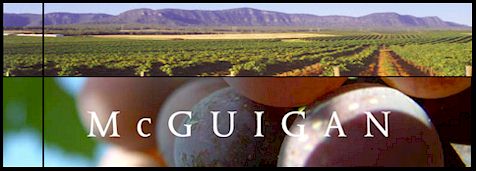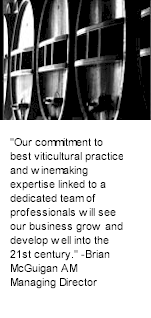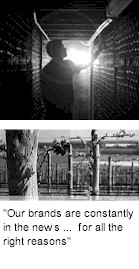


Brian McGuigan is recognised as a trailblazer in viticulture, with world class vineyards utilising best viticultural practices. McGuigan was named Australian Wine Company of the Year at the 2003 Winestate Magazine Awards. The Award was given on the strength of McGuigan's wines in extensive tastings run by the magazine during the past 12 months. All the tastings are run 'blind', assuring that wine quality is the only measure.

Four generations of the McGuigan family have made wine their life. Some of Australia's greatest brands have been shaped by the McGuigan spirit, and their 80-plus years of winemaking. McGuigan Simeon is the second largest vineyard holder in Australia, with vines planted across all the premium regions in the country. Most of the vineyards are located in the upper and Lower Hunter Valley, Cowra, Mudgee, the Barossa Valley, Limestone Coast and the Riverland.
From a standing start in 1992, McGuigan Wines now has the 2nd largest vineyard holdings in Australia. This capacity translates to more than 225,000 tonnes across the group. To process these quantities, five state of the art wineries run year round, each with very specific winemaking duties.
The Buronga Hill winery is one of the largest in Australia. Established in 1984 in the Sunraysia district, it is designed for large-scale, high quality winemaking. New technologies are introduced each year to the winery, which crushes in excess of 100,000 tonnes of fruit annually. The intake of grapes comes from 500 local contract growers, who are part of an extended family. Winemaker Kim Hart is in charge of this imposing facility, and is in regular contact with each of the growers, ensuring a continuous supply of high-quality material to the winery.

Located just down the road from Hunter Ridge, the Hermitage Road winery is among the top three in the Hunter Valley for both size and technical excellence. This winery crushes around 6000 tonne of fruit each vintage, drawing from the Hunter Valley, Mudgee and Cowra. The winery also processes a further four million litres of juice from other vineyards throughout Australia.
The McGuigan Wineries are at Hunter Ridge and Hermitage Road in NSW, Yaldara in the Barossa Valley, Buronga in Sunraysia, and Loxton in the NSW Riverland. Built in 1989, the technologically advanced winemaking, blending and maturation facility at Hermitage Road was specially constructed and equipped to handle premium grapes and juice in a focused and special way. Accordingly, the wines produced here are premium McGuigan products, such as Personal Reserve and Genus 4. With a capacity to produce up to 50,000 cases of top quality wine, the winery has more than 2000 oak barrels (French and American oak) and 50 small maturation and blending tanks. Peter Hall oversees the management of Hunter Ridge, which is located on Hermitage Road in Pokolbin.
The Loxton winery has been a fixture in Australia's historic Riverland since 1948. Over the years, technologies have been introduced to make the winery capable of crushing 64,000 tonnes every year. While technology allows this growth, a strong focus on small batch processing for premium wines remains. More than half of the grape supply processed at Loxton is sourced from company vineyards.
The acquisition of Yaldara winery in 2001 allowed a considerable expansion of the McGuigan winemaking facilites. The Yaldara winery was built in 1947, and is one of the biggest facilities in the Barossa Valley. Most significantly, the Yaldara facility allows small batch processing of some of McGuigan's most popular wines, including the Bin Range. Quality barrel fermentation is now spread across more of the portfolio, and quality has increased markedly. The Yaldara winery, seeping with history, is responsible for McGuigan's South Australian production. Winemaker Thomas Jung manages the winemaking, bottling and maturation with strict guidance and expert care.
